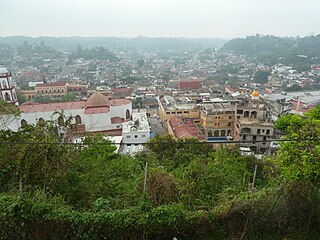Papantla de Olarte, often simply known as Papantla, is a vibrant city in the state of Veracruz, Mexico, famed for its rich indigenous heritage, particularly of the Totonac people. It is renowned worldwide for its vanilla, which is indigenous to the region, and for the spectacular Voladores de Papantla, a ritual where performers fly from a 30-meter pole to represent the elements of earth and sky. The city itself offers a charming mix of colonial architecture, lively markets, and cultural museums, making it a unique destination for those interested in history, culture, and traditional practices.
Plan your visit to coincide with the Cumbre Tajín festival in March, where you can experience a vibrant display of Totonac culture, music, and dance performances.
While in Papantla, make sure to visit the El Tajin archaeological site just outside the city; it’s a crucial part of Mexico’s pre-Hispanic history and a World Heritage Site.
Top things to do & see in Papantla de Olarte
Select the following sights and activities to discover best tickets and tours available in Papantla de Olarte.
Papantla de Olarte: A Glimpse into Mexico’s Rich Heritage
| Country | Mexico |
| Time in Papantla de Olarte | GMT-6 |
| Language spoken | Spanish |
| Population | 50,870 (source: INEGI Census 2020) |
| Currency | Mexican Peso (MXN $) |
| Airports |
|
Papantla de Olarte, often simply referred to as Papantla, is nestled in the north of Veracruz, Mexico. This small yet historically significant town is renowned for its rich indigenous heritage, particularly of the Totonac people, and its cultivation of vanilla. Recognized also for the mesmerizing ‘Voladores de Papantla’ ritual—an intangible heritage acknowledged by UNESCO—Papantla mesmerizes visitors with a combination of traditional cultures and natural beauty.
Where is Papantla de Olarte?
Papantla de Olarte is located in the state of Veracruz, in the eastern part of Mexico. It lies in a fertile region known for agriculture.
Distances:
| Route | Distance by Car | Time by Car |
|---|---|---|
| Mexico City to Papantla de Olarte | 196 miles / 315 km | Approx. 4 hours and 30 minutes |
| Veracruz to Papantla de Olarte | 125 miles / 201 km | Approx. 2 hours and 45 minutes |
| Puebla to Papantla de Olarte | 170 miles / 274 km | Approx. 3 hours and 50 minutes |
What is Papantla de Olarte famous for?
Papantla is famous for being the cradle of the ancient Totonac civilization and the place where vanilla was first cultivated. The ‘Voladores de Papantla’, a daring aerial performance by indigenous dancers, is a spectacular cultural emblem associated with the city.
History
Pre-Columbian Period (Before 1519)
The region of Papantla de Olarte, located in the modern-day state of Veracruz, Mexico, has a rich historical tapestry dating back to ancient times. Initially inhabited by the Totonac people, a Mesoamerican civilization known for their advanced urban development and distinctive culture, Papantla was a significant node in their extensive trade networks. The Totonacs were renowned for their contributions to agriculture, particularly vanilla, which is native to this region.
Colonial Era (1519-1821)
With the arrival of the Spanish in the early 16th century, Papantla came under the sway of European influences. The Spanish conquest led by Hernán Cortés saw Papantla become a crucial area in the colonial administration due to its productive lands and strategic position. During this period, many of the indigenous people were converted to Christianity, and their societal frameworks were altered significantly by the incorporation of Spanish culture and governance.
Post-Independence Era (1821-Present)
Following Mexico’s independence from Spain in 1821, Papantla gradually transitioned into a more nation-focused development path. The city continued to evolve, maintaining its importance as an agricultural hub, especially in the cultivation of vanilla. In the contemporary era, Papantla remains a vibrant testament to its multi-layered history, blending indigenous traditions with colonial histories in its architecture, culture, and community life. Today, it is also known for hosting the annual Cumbre Tajin festival, celebrating the rich heritage of the Totonac people and other indigenous groups.
Visit Papantla de Olarte
What to see and do in Papantla de Olarte, Mexico
Visitors to Papantla de Olarte are greeted with a rich blend of historical and cultural attractions. Essential sights include:
- The iconic El Tajin, a nearby pre-Columbian archaeological site known for its unique pyramidal structures and advanced understanding of astronomy.
- The Church of Nuestra Señora de la Asunción, showcasing colonial architecture and intricate religious art.
- Local vanilla plantations, where the world-renowned Papantla vanilla is cultivated.
Additionally, encountering the ‘Voladores de Papantla,’ ritual performers who enact ancient rites through aerial dances, is a must.
Cultural Festivities in Papantla de Olarte
Papantla de Olarte hosts various events throughout the year, drawing visitors to experience its rich cultural tapestry. Notable among these is the Cumbre Tajin festival, typically held in March, which celebrates the spring equinox with a mix of traditional music, dance, and crafts showcasing the heritage of the Totonac people and other indigenous groups.
Best time to visit Papantla de Olarte
The best time to visit Papantla de Olarte is during the dry season from December to April. This period offers the most pleasant weather for exploring outdoor sites like El Tajin and also coincides with the Cumbre Tajin festival, providing a full cultural experience.
Is Papantla de Olarte worth visiting?
Papantla de Olarte is undoubtedly worth visiting for anyone interested in history, culture, and nature. Its unique blend of indigenous Totonac heritage and colonial history, manifested in spectacular historical sites, cultural festivals, and natural beauty, provides a profound and enriching experience that captivates visitors. Whether you’re exploring ancient ruins or witnessing the breathtaking Voladores de Papantla, the city offers a window into the past and a celebration of enduring traditions.









